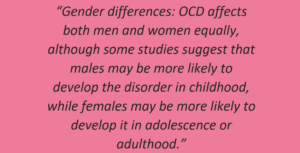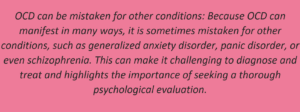
Obsessive Compulsive Disorder: Conceptual Knowledge and Treatment
Cristian Chereches, RSW, Psychotherapist
What is Obsessive Compulsive Disorder (OCD)?
Obsessive-compulsive disorder (OCD) is a condition that affects millions of people worldwide. It is characterized by persistent, intrusive thoughts (obsessions) and repetitive behaviors (compulsions) that are intended to reduce anxiety. OCD can significantly impact a person’s daily life and can be extremely distressing, but with proper treatment, many people are able to manage their symptoms effectively.
Causes of OCD:
The exact cause of OCD is not yet known, but research suggests that a combination of genetic, environmental, and neurological factors may play a role.
1. Genetics: Studies have shown that OCD tends to run in families, suggesting that genetics may be a contributing factor. Certain genetic variations may increase a person’s risk of developing OCD.
2. Brain chemistry: OCD is thought to be related to imbalances in certain chemicals (neurotransmitters) in the brain, such as serotonin and dopamine. These chemicals help to regulate mood, behavior, and anxiety, and disruptions in their levels may contribute to the development of OCD.
3. Environmental factors: Traumatic life events, such as abuse, neglect, or loss, may trigger the onset of OCD symptoms in some people. Other environmental factors, such as infection, illness, or exposure to toxins, may also play a role.
4. Neurological factors: Imaging studies have shown that people with OCD have differences in brain structure and function compared to those without the disorder. Specifically, there appears to be overactivity in certain areas of the brain that are involved in fear and anxiety.
Symptoms of OCD:
OCD is characterized by two types of symptoms: obsessions and compulsions.
Obsessions are unwanted, intrusive thoughts, urges, or images that cause significant distress or anxiety. Common obsessions include fear of contamination, fear of harm to oneself or others, and obsessive thoughts about morality or religion.
Compulsions are repetitive behaviors or mental acts that are performed in response to an obsession in order to reduce anxiety or prevent harm. Common compulsions include excessive cleaning or washing, checking behaviors, and counting or repeating certain words or phrases.
Diagnosis:
OCD is typically diagnosed based on a person’s symptoms and a thorough psychological evaluation. Treatment for OCD usually involves a combination of medication and psychotherapy.
Our Approach to Treatment
We use a combination of Inference Based Cogntive Behavioural Therapy (I-CBT) and Exposure and Response Prevention (ERP) to address alternate belives that maintain symptoms as well as gradually expose patents to their fears or obsessions while preventing them from engaging in their usual compulsions. This helps to break the cycle of anxiety and compulsive behavior and allows the person to gradually learn to tolerate their obsessions without performing compulsions.
What is Inference Based Cognitive Behavioural Therapy (I-CBT)?
Inference-based Cognitive-Behavior Therapy (I-CBT) is an evidence-based treatment that is based on the central idea that obsessions are abnormal doubts about what “could be”, or “might be” (e.g. “I might have left the stove on”; “I might be contaminated”; “I might be a deviant”).
According to this approach, obsessional doubts do not come unexpectedly, but they arise as the result of a dysfunctional reasoning narrative that is characterized by a tendency to distrust the senses and an over-reliance on the imagination. As a result, obsessional doubts can persist without ever being resolved by conducting compulsions.
Standard Cognitive Behavioral Therapy (CBT) is based on the idea that obsessions find their origin in random intrusive cognitions, which develop into obsessions depending on how the person interprets them. For example, a person with a random intrusive thought about harming someone will develop obsessions only if these thoughts are negatively interpreted. Consequently, standard CBT is focused on helping patients to no longer misappraise or negatively react to these thoughts. It does not really address the initials thoughts preceding the appraisal.
I-CBT takes a different approach. While intrusive thoughts are normal, and they occasionally occur to everyone, obsessions are not viewed as originating from random intrusive thoughts. Instead, I-CBT views obsessions as inferences or doubts that come about due to prior reasoning.
Obsessional doubts are problematic from the get-go, regardless of whether they appraised negatively after the fact.
I-CBT aims to bring resolution to obsessional doubts by teaching patients that obsessional doubts do not arise in the same way as normal doubts. Normal doubts come about for legitimate reasons and are relevant to the here-and-now, whereas obsessional doubts never are.
Throughout treatment, patients are encouraged to trust their inner and outer senses, which leaves no room for obsessional doubts. Fortunately, those with OCD already reason just like everyone else in most non-obsessional situations, so there is nothing new to learn, except to apply the same to the obsessional situation.
There is a large body of scientific literature supporting the central claims of I-CBT, including randomized controlled trials that have shown I-CBT to be an effective treatment for most of those suffering from OCD.
I-CBT is also a promising alternative treatment option for those who have been unable to benefit from other treatments.
What is Exposure and Response Prevention (ERP)?
Exposure and Response Prevention (ERP) is a type of therapy that is considered the most effective treatment for OCD. It involves two key components: exposure and response prevention. Here is an explanation of each:
Exposure: In ERP, individuals with OCD are deliberately exposed gradually, based on a tolerance scale to situations, thoughts, or images that trigger their obsessive and anxiety-provoking thoughts. These exposures are designed to evoke anxiety or discomfort like what the person experiences during their obsessive episodes. The exposure exercises are customized to the specific obsessions and compulsions of the individual.
Response Prevention: This component involves instructing the individual to resist or prevent engaging in their usual compulsive behaviors or rituals that they use to reduce anxiety or distress. People with OCD typically engage in these behaviors to neutralize their obsessions or reduce discomfort. In ERP, they are encouraged to confront their obsessive fears without engaging in compulsions, allowing the anxiety to naturally subside over time.
The idea behind ERP is to help individuals with OCD learn that their anxiety will decrease on its own without needing to perform compulsive behaviors. Over time, through repeated exposure to anxiety-provoking situations and the prevention of their usual responses, the individual’s brain begins to adapt and learn that the feared consequences are unlikely to occur. This helps to reduce the power of obsessions and compulsions.

Virtual Reality Exposure Therapy
Virtual Reality Exposure Therapy (VRET) is a modern and innovative approach to exposure therapy that uses virtual reality (VR) technology to treat various psychological and emotional conditions, including phobias, anxiety disorders, and OCD. VRET works by creating a controlled and immersive virtual environment that allows individuals to confront their fears or triggers in a safe and therapeutic manner.
Computer-based treatments were the first innovative use of technology for treating OCD. Virtual reality also holds promise as a valuable technology-based treatment option. Recent studies have shown that exposure and response therapy (ERP) designed to address OCD symptoms, may be valuable in virtual reality format.
During a VRET session, the individual wears a VR headset and enters the virtual environment. They are gradually exposed to their feared stimuli or situations in a controlled and graded manner. This exposure is carefully designed to provoke anxiety or discomfort, like traditional exposure therapy.
Realistic Experience: Virtual reality is immersive, and individuals feel a sense of presence in the virtual environment. This heightened sense of realism can make the exposure more effective in triggering emotional and physiological responses.
Therapeutic Guidance: A trained therapist or clinician guides the individual through the VR exposure sessions. They provide support, monitor the individual’s reactions, and help with coping strategies during the process.
VRET has several advantages over traditional exposure therapy, including enhanced safety, control, and the ability to customize scenarios to the individual’s needs. It can also be more engaging and motivating for some patients.
Research suggests that VRET can be highly effective in reducing symptoms and improving the quality of life for individuals with various anxiety-related and trauma-related conditions. It is a promising and evolving approach in the field of mental health treatment.
Facts about OCD
- Prevalence: OCD is estimated to affect around 1-2% of the population worldwide.
- Age of onset: OCD can develop at any age, but it most commonly begins in childhood, adolescence, or early adulthood.
- Comorbidities: OCD is often associated with other mental health conditions, such as depression, anxiety disorders, and eating disorders.

- Disability: OCD can significantly impact a person’s daily life, and in severe cases, it can be disabling. According to the World Health Organization (WHO), OCD is one of the top 20 causes of disability worldwide.
- Treatment success: With proper treatment, many people with OCD are able to manage their symptoms effectively. Research suggests that up to 70% of people with OCD who receive treatment experience significant improvement in their symptoms.
- Economic impact: OCD can also have a significant economic impact, due to the cost of medical treatment, lost productivity, and other associated expenses.
- It’s worth noting that while these statistics provide some insight into the prevalence and impact of OCD, they are not definitive, and the exact numbers may vary depending on the source and methodology of the studies. Additionally, many people with OCD may not seek treatment or may not be diagnosed, so the true prevalence of the disorder may be higher than reported.
Less known facts about OCD
- OCD was once considered a rare disorder: Despite being one of the most common conditions, OCD was once considered a rare disorder. In fact, it was not until the 1980s that it became more widely recognized and diagnosed.
- OCD can manifest in many ways: OCD is a highly diverse disorder and can manifest in many ways. Some common obsessions include fear of contamination, fear of harm to oneself or others, and obsessive thoughts about morality or religion. Some common compulsions include excessive cleaning or washing, checking behaviors, and counting or repeating certain words or phrases. However, there are many other obsessions and compulsions that a person with OCD may experience.

- OCD is not caused by personal weakness or moral failing: Despite persistent myths and stereotypes, OCD is not caused by personal weakness, lack of willpower, or moral failing. Rather, it is a complex disorder that is influenced by a variety of genetic, environmental, and neurological factors.
- Some famous people have struggled with OCD: Many famous people throughout history have struggled with OCD, including Leonardo da Vinci, Howard Hughes, and Charles Darwin. Some modern-day celebrities who have spoken publicly about their OCD include soccer player David Beckham and actor Amanda Seyfried.
- OCD can affect animals too: Although OCD is most associated with humans, it can also affect animals. For example, dogs may exhibit repetitive behaviors such as excessive licking or tail chasing, while birds may engage in excessive grooming or feather plucking.
- OCD is treatable: Although OCD can be a challenging condition to live with, it is treatable. With proper diagnosis and treatment, many people with OCD can manage their symptoms effectively and lead fulfilling lives. Treatment options may include medication, psychotherapy, or a combination of both.
Sources:
- Clinician’s Handbook for Obsessive Compulsive Disorder: Inference-Based Therapy Paperback – Illustrated, Dec 12, 2011, by Kieron O’Connor, Frederick Aardema
- Anxiety provocation and measurement using virtual reality in patients with obsessive-compulsive disorder – Kwanguk Kim 1, Chan-Hyung Kim, Kyung Ryeol Cha, Junyoung Park, Kiwan Han, Yun Ki Kim, Jae-Jin Kim, In Young Kim, Sun I Kim Dec;11(6):637-41. Doi: 10.1089
